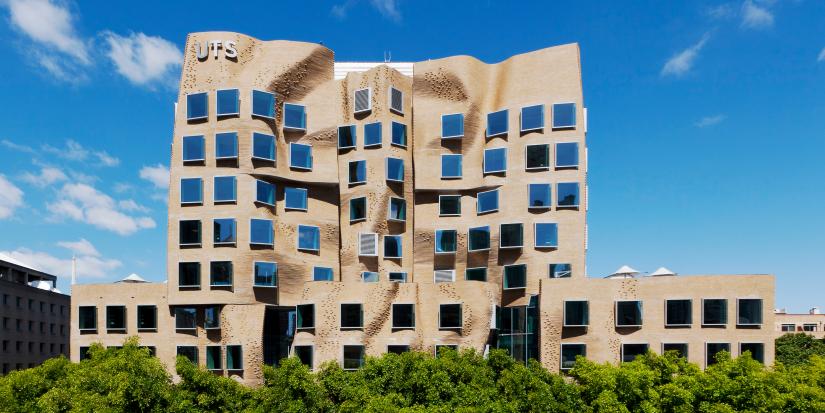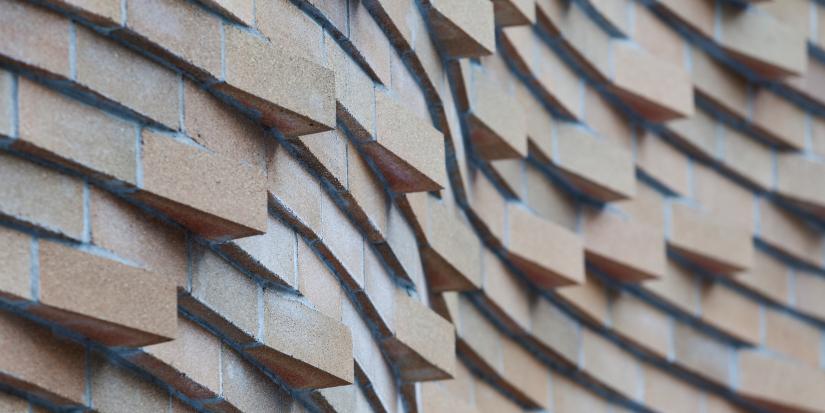
The Chau Chak Wing building. Image: Andrew Worssam
It’s been described as resembling “a crumpled paper bag” and a treehouse. UTS’ new Business School, the Chau Chak Wing building designed by Frank Gehry, is the first structure by this renowned Canadian/American architect in Australia and researchers at UTS’ Engineering faculty have also played a significant role as material advisors for the interior and exterior.
“We are very lucky that UTS now has such a world-class building on our campus, and whilst UTS didn’t design and build it we have used our own world-class experts to advise on the project,” says Professor Keith Crews from UTS’ School of Civil and Environmental Engineering.
One of the most memorable and original aspects of the building – named after the Australian-Chinese businessman and philanthropist Dr Chau Chak Wing, who donated $20 million to the project – is its undulating brickwork exterior.
In his design brief, Gehry himself described the fluidity he envisaged: “The form of this façade curves and folds like soft fabric. The brick will be set in horizontal courses and will step or corbel to create the shape.” His brief also specified that all 320,000 bricks were custom-made, differing from standard bricks with a groove in the middle.
The biggest challenge to execute this design is its uniqueness, says Crews, who worked with consultants (AECOM) on behalf of UTS, to test the façade’s stability and structural soundness.
“When a façade has never been built before you want to ensure that bricks aren’t going to fall out and that it is stable under extreme pressure,” Crews says. “There were no Australian/New Zealand standards we could refer to on this.”
So Crews’ team built a three metre wide by five metre high and 1.5 metre deep model mock wall, using these custom bricks and then tested the structure themselves.
Admittedly the façade is not designed to bear the structural weight of the building, and each brick is tied with metal ties backwards into the internal structural substrate panels beneath for reinforcement, but its skin still has to resist winds of high velocity.

Detail of the undulating brickwork on the Dr Chau Chak Wing building facade. Image: Andrew Worsamm
“Over about a six month period, we applied over 100 load tests to our mock wall to see if it stood up, simulating winds of over 150 kms an hour. We also had to assess how all aspects of the building would interact together,” Crews says.
And after collaborating with AECOM and only making some small fine tuning adjustments, no part of the design had to change, and the UTS team approved the façade. “I think our involvement gave everybody a high level of comfort,” he says. “We provided a risk assessment that they really appreciated.”
Crews also advised ARUP (the Australian designers) on aspects of the internal structure. Whilst most of the building is made of masonry and concrete, Gehry designed two oval classrooms one above the other, affectionately referred to as the Bird’s Nest, made from large timber beams within the ground-floor atrium void
We were engaged to look at the possible movement in the timber,” Crews says. “If timber shrinks and dries out this could lead to structural movement and this could crack the glass panels and reduce sound proofing, and this would be a major problem.”
In their report Crews recommended that ARUP use glued and laminated timber, sealed in very controlled conditions. In total ARUP used a total of 150 beams, each up to 12m long, manufactured from radiata pine, sourced from plantations in NZ.
As well as the ceiling beams, ARUP also called on Crews’ expertise for the timber concrete composite flooring throughout the classrooms, which UTS has been researching and developing for over a decade, with two Post-Doctoral students and seven PhD students working on this research.
“We have developed flooring that is efficient for a long spanning floor that is comfortable to walk on,” he says. “Timber is a quarter of the weight of concrete, so it makes a lighter structure and our new construction technique also reduces vibrations for the floors below.”
The classrooms now feature what is believed to be the world’s longest timber-concrete composite floor and the first of its type in Australia and NZ.

